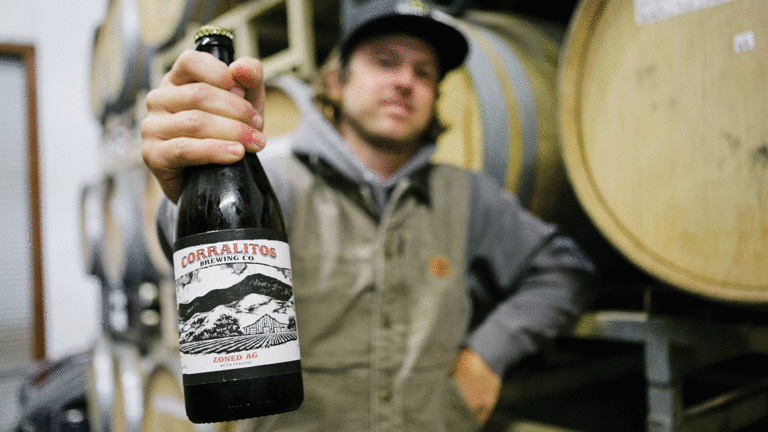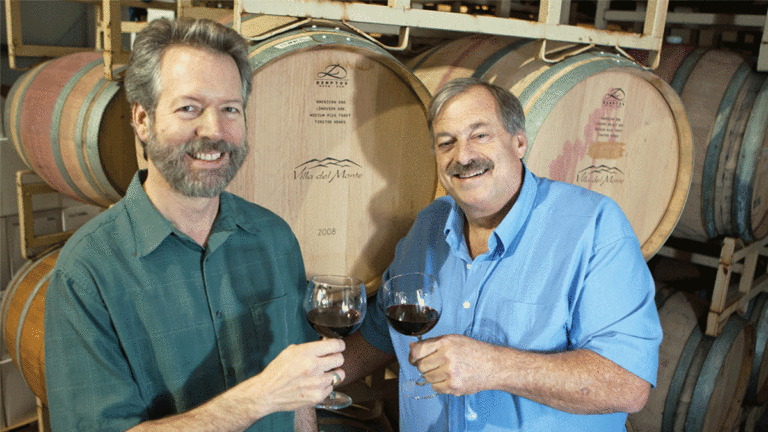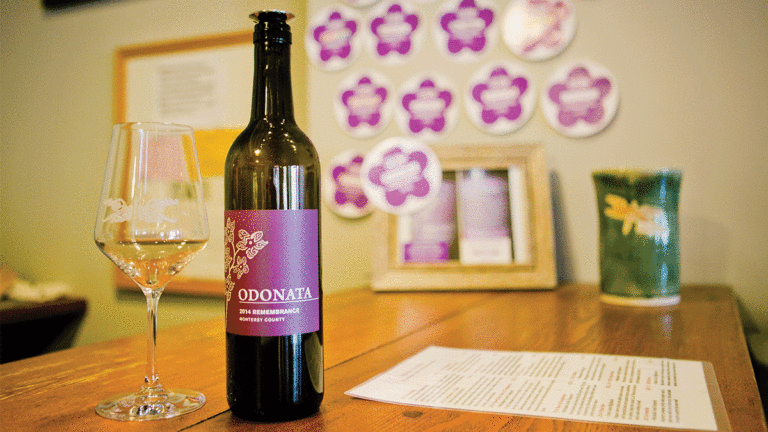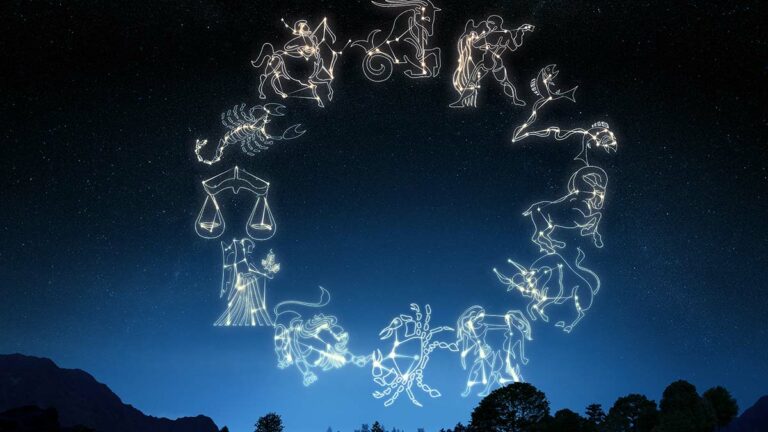One night three years ago, a group of roughly 10 people spilled onto Front Street from the Museum of Art and History, leaving the sound of music and cheering behind them. More followed, and soon a stream of bodies poured onto Soquel Avenue, bottlenecking as the crowd squeezed close to cross the bridge. Once on the other side, they pooled at the edge of the San Lorenzo River, one stream of life and purpose joining another.
That was the first Ebb and Flow, a series of events put on by local nonprofits to encourage Santa Cruz citizens to get better acquainted with the San Lorenzo River. It began with live music and dancing at the Museum of Art and History, and ended with the unveiling of new art installations and a movie projected onto the underside of the Soquel Avenue bridge.
This weekend, Ebb and Flow returns for its third year, with events ranging from scientist-led tours to a kinetic art parade, where participants unveil moving, river-inspired sculptures. These events mark an ongoing effort from groups like the Coastal Watershed Council, the San Lorenzo River Alliance, the Tannery Arts Center and others to enhance the Santa Cruz community’s relationship with its primary water supply, and to gather support for its stewardship. But are these events enough to inspire a healthy relationship between a community and its river, and how much work remains to restore a watershed that its stewards describe as “abused for over hundreds of years?”
One Stormy Afternoon
When a series of winter storms peaked on Feb. 7, office workers in Downtown Santa Cruz witnessed something no one had seen in decades: the San Lorenzo River rose to nearly 24 feet, reaching its largest volume since 1982. Laurie Egan, outreach and development manager for the Coastal Watershed Council, first heard about the impending storms from her boss, Greg Pepping.
“He had just moved near the river,” says Egan, “and that morning he told me, ‘My house might flood today. I have to run home to make sure I have sandbags.’” Egan rushed downtown later that day to join hundreds who had left their offices to see the river.
“We saw folks from downtown businesses, and kids with their parents coming home from school,” says Egan, who joked that the council should have set up a table in the rain to field questions on the river. “It was a really cool draw for the whole community to come out in the middle of their work day and see the river like no one had seen it before.”
Pepping’s house, along with the rest of downtown, did not flood. Egan says this past winter’s storms were the first time the river’s levees were truly tested, and, thanks to their design and the city’s earlier efforts to clear debris from beneath the Water Street bridge, everything went as planned. “The river kept rising, rising, rising, and it spilled into San Lorenzo Park, just as it was designed to do,” she says.
The storms induced mudslides, toppled trees onto Highway 17, and caused mountain roads to crumble into the earth. But they also marked the end of California’s drought, which Gov. Jerry Brown declared over the following month. And it signaled some recovery for the San Lorenzo River watershed, though city officials say years of water deprivation can’t be undone so quickly.
“As far as I can tell, the storms have really helped,” says Chris Berry, the city of Santa Cruz’s watershed compliance manager. According to Berry, rushing winter waters flushed fine sand downstream, making way for coarser gravel, which means better habitat for fish. Species like coho and steelhead that swim upstream from the river’s mouth prefer to lay their eggs in coarse sand, as fine silt tends to smother their offspring.
This past summer, Berry says his group logged the highest count of steelhead in the San Lorenzo River lagoon since they began counting in 2008. “We know it’s a good year when we have so many fish that we can’t count them all.”
But the rains weren’t solely good, he adds, as coho that traveled into the San Lorenzo River earlier in the season likely had their eggs flushed out prematurely. And fish who attempted to wait out the storm before depositing their eggs may have waited too long, ultimately having to ditch their eggs before reaching the quiet pools they normally rely on. The coho salmon population in the San Lorenzo is still far below healthy levels, he says.
John Ricker, water resources program coordinator for Santa Cruz County, shares similarly mixed results on the county’s water supply.
“The recent rainfall is great,” says Ricker, “but it hasn’t recovered what we’ve lost over the last 30 years.”
Beneath the Surface
Though the river’s rising height may imply surplus, it’s a different story beneath the soil that lines its course. There, deep beneath the ground, are aquifers: sections of porous rock that store groundwater. The whole Scotts Valley area depends entirely upon groundwater, says Ricker, and the San Lorenzo River receives 40 percent of its water from those same aquifers.
Usually, rainwater trickles through permeable soils and drains into the earth, eventually finding its way to the aquifers, where it can later be extracted. But when that soil is paved over with asphalt or other impermeable materials, the water never makes its way through, instead flowing off roads and parking lots, where it erodes hillsides. Much of those surfaces throughout Scotts Valley have been paved over, says Ricker.
Despite the challenges, Ricker is hopeful that the county is moving toward sustainable management of its water resources. In 2014, Gov. Brown signed the Sustainable Groundwater Management Act into legislation, which put the onus on local agencies to work toward better management of their groundwater resources. Before the legislation, Ricker says groundwater regulation was something out of the Wild West.
“You have to get a permit from the state to extract surface water, and it’s been that way for 100 years,” says Ricker. “But with groundwater, it took them 100 years to reach the same level of regulatory oversight.”
Though they haven’t yet settled on a recovery plan, Ricker’s group is looking down several avenues, the first of which entails “conjunctive use.” Ricker says that under this strategy, the city would draw water from varying sources, depending on where it’s most available.
In the winter, the city would draw from surface water when those levels are higher. During summer, relying on groundwater storage would leave more surface water for fish. Ricker’s team has even retrofitted some Scotts Valley parking lots to make them permeable, allowing more water to pass through and into aquifers below. He encourages private landowners to similarly avoid laying pavement on their property, instead opting for gravel roads and driveways.
Though the basin is over-drafted, Ricker says he’s hopeful they’ll reach a state of sustainable management by 2040.
“I think it’s very likely,” he says. “We’ve already reduced the amount of pumping from the basin to the point where its levels are no longer dropping.”
Too Many Straws
Berry, however, is concerned that Santa Cruz citizens are adding demand to what he describes as an over-appropriated “working watershed.”
“The river has a long history of insults and abuse. And let’s face it, it’s been developed since the 1800s,” says Berry, referencing the river’s history of overfishing, clear-cutting trees to rebuild San Francisco, and general industrialization over the past 150 years.
Today, says Berry, the river is more appropriated than ever. Cabins meant for summer-use only are now occupied year-round, new sections along the river are being developed, and an agricultural newcomer to the Santa Cruz Mountains could further exacerbate the issue.
“We have a huge, new industry that just moved into the watershed in the recent past, meaning commercial cannabis cultivation,” says Berry. Compared to wine, Berry says marijuana is a “thirstier crop” than grapevines. But he’s quick to acknowledge that the problem isn’t cannabis specifically—it’s a matter of adding one straw too many.
“There’s too many straws in too small a bucket. Unfortunately, with the commercial cannabis industry’s growth, we’re adding even more straws to that, and that’s a challenge.”
Like Ricker, Berry’s team is working toward sustainable management of our water supply. His team is only just beginning to develop a suite of conservation strategies, from purchasing and invalidating unused water rights to working with private landowners to better manage their riverside property. Berry advises individuals to clean up their pet waste—as bacteria can wash into the river—to allow native vegetation to grow wild in their yards, and to call the city before removing logjams from the river, as they provide prime habitat for fish.
“I’m feeling pretty good about the local energy,” says Berry. “People in Santa Cruz have a pretty strong environmental ethic, and they want to manage their resources locally. That’s why I enjoy working here.”
Citizen Scientists
“I found fungi,” shouts a bodiless voice from behind the bushes lining the banks of the San Lorenzo River. “Where’s the fungus expert?”
It’s Earth Day, three years since Ebb and Flow began, and all but a crowd of roughly 20 people have disappeared into the riverside vegetation. They’ve gathered to participate in a BioBlitz: a creature-counting event put on by the Coastal Watershed Council and the Santa Cruz Museum of Natural History, where participants photograph and log living organisms, from saplings to spiders.
“The BioBlitz is one of the many ways the Coastal Watershed Council uses citizen science to engage the community with the environment around them,” says Laurie Egan, who helped find animal experts to join the hunt. “It’s a chance to put on your naturalist hat and see what it’s like to identify the birds and bugs and bees along the river, and to get a sense of how diverse this ecosystem is right in our own backyard.”
Plot by plot, they part grass blades and bend tree branches to catch a glimpse of creatures both big and small. Margo Ross, a kindergarten teacher at Tierra Pacifica Charter School, pulls a piece of wood aside to reveal a white mushroom sprouting from light, sandy soil. An iPhone emerges, its camera shuttering audibly, and the mushroom is uploaded.
The days of the San Lorenzo River being rich with fish may be gone. But, with the aid of a smartphone, it’s clear that the river is still teeming with life. Attendees of the BioBlitz are using iNaturalist: an app designed to map sightings of living things. iNaturalist began as a collaborative project between students at UC Berkeley and Stanford, and was adopted by the California Academy of Sciences in 2014 in an effort to harness the power of citizen scientists. If the image users uploads are sufficiently detailed, researchers use them to track changes in plant and animal populations.
Open the app near San Lorenzo Park and you’ll find dozens of colored markers, each depicting a sighting. Images on the app show hawks perched on parking meters, gophers peeking out from underground tunnels, and spiders dancing across people’s palms. Once the day was over, the group had logged more than 260 sightings, comprising more than 80 species.
The BioBlitz marks just one event put on by the Watershed Council and other nonprofits in an effort to get the Santa Cruz community to be better engaged with the river. Similarly, the Santa Cruz County Arts Council is trying a different route: art installations.
Each year, the council offers grants to local artists to erect river-themed art along the San Lorenzo Riverwalk. From oversized fishing poles to a large sculpture wrapped in fishing rope, the Arts Council hopes these pieces will inspire conversation about the river.
“The idea is to bring people to a place where, typically, they don’t feel safe,” says Michelle Williams, executive director of the Arts Council. “But with hundreds of us, it’s going to be awesome. Once you’ve been on the riverwalk at night with 200 other people, you’re going to feel differently about it.”
The art continues beyond the riverwalk, with a river-focused installation in the Museum of Art and History’s Atrium. There, an interactive screen depicts waters of the San Lorenzo River. Trace your finger across its screen, and large, historical images of the river project onto the museum wall.
Williams hopes these pieces not only inspire conversation, but also bring bodies onto the riverwalk. Ultimately, she hopes that river-facing businesses on Front Street—a recent topic of discussion to emerge from the March 17 Riverwalk Engagement Summit, where environmental groups and local government gathered to discuss the progress of the riverwalk—will bring even greater attention.
“I feel like our backs, as buildings and as people,” says Williams, “have been turned to the river. Both literally and metaphorically, we need to turn back toward it.”
Muddy Path Forward
Back near the Soquel Avenue bridge, Jane Mio hones the focus of her monocular. Her gaze is fixed on bushes just beneath the bridge. There, perched on a swaying branch, is a large hawk.
“So many of us think we have to get in the car or on our bikes to travel to some place to be with nature, to get that peaceful moment.” says Mio, who regularly leads birding tours as the conservation officer of the Santa Cruz Bird Club. “But if we really took care of the river, we could have that right here,” she says, shifting her gaze further upstream.
Mio often works with the Valley Women’s Group to clear invasive vegetation from the lower river, making way for native plants that bring more cover and cooler waters for fish. That vegetation, combined with a recent uptick in the amount of water flowing through the lower portion of San Lorenzo River, say city officials, could mean better rearing conditions for fish in the summertime.
When Mio first moved to Santa Cruz in 1972, she recalls seeing fishermen standing shoulder to shoulder along the river’s edge, adding to the already tall piles of fish at their feet. She remembers that the river was different then, when even snakes and lizards seemed more plentiful.
“I’m not sure we’ll ever get back to that,” says Alev Bilginsoy, river scientist at the Coastal Watershed Council, acknowledging that those days may long be gone. She adds, however, that the Santa Cruz community is better served by focusing on the present moment.
“I think it’s important for people to look past that, and to allow themselves to have a new, authentic experience of this ecosystem. It’s still here, it’s still thriving, it’s just evolved in a way that may seem unfamiliar, but that’s even more reason for people to go out and explore it.”
With much work left to do, the task of restoring the San Lorenzo watershed may seem overwhelming to some. Mio is discouraged by the prospect of more development along the river, though she draws inspiration from the very creatures that dwell there.
She turns her gaze to the cliff swallows, which migrate thousands of miles from South America to build their mud houses under the bellies of our bridges. Mouthful by mouthful, Mio says, the birds scoop up gobs of mud, mix it with their saliva, and use the material to build their muddy, dome-shaped nests beneath the bridges. Just one nest can take 500 trips, she says.
Mio recently visited her grandson’s class to teach the natural history of native birds, and told them of the cliff swallow’s ironclad will.
“So many times the kids say, ‘I can’t do this, I can’t do that.’ I tell them, ‘Look how small these birds are, and how big you are. Those little birds never say they can’t do it. They just do it.’”












 In this issue of Food & Drink magazine, we’re on a spicy kick. First, Christina Waters looks at how Mexican specialties are all the rage at upscale restaurants locally. It’s interesting not only in the way it expands the definition of Mexican cuisine in a taqueria-rich dining scene, but also because, in some cases, chef talents like Gema Cruz of Gabriella Cafe are getting an outlet to explore their heritage. Cruz grew up cooking with her grandmother in Oaxaca, and now Gabriella is hosting a special night each week that features dishes from the region.
In this issue of Food & Drink magazine, we’re on a spicy kick. First, Christina Waters looks at how Mexican specialties are all the rage at upscale restaurants locally. It’s interesting not only in the way it expands the definition of Mexican cuisine in a taqueria-rich dining scene, but also because, in some cases, chef talents like Gema Cruz of Gabriella Cafe are getting an outlet to explore their heritage. Cruz grew up cooking with her grandmother in Oaxaca, and now Gabriella is hosting a special night each week that features dishes from the region.











